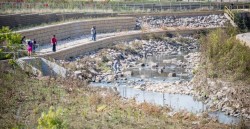Sewerage District a National Leader
MMSD leading the way in finding green solutions to storm water pollution.

People were down by the river watching the salmon run in the river up to where the concrete lining was removed up to the 6th Street Bridge. Photo by Dave Schlabowske.
Chicago architect Daniel Burnham famously said, “Make no little plans. They have no magic to stir men’s blood .” The folks at the Milwaukee Metropolitan Sewerage District (MMSD) are taking Burnham’s advice when it comes to comprehensively deploying green infrastructure strategies to better manage stormwater.
Recently, the National Resources Defense Council (NRDC) released an update to our 2011 report Rooftops to Rivers II, which shows how, in just two short years, cities and regions of all sizes are using green infrastructure to manage their stormwater and revitalize their communities.
MMSD’s efforts are worthy of special note: with approval of its Regional Green Infrastructure Plan, MMSD becomes the second city or region in the nation to achieve all six of NRDC’s Emerald City criteria identified in Rooftops to Rivers II. The plan identifies a goal of capturing 740 million gallons of stormwater per rain event and lays out a systematic approach to achieve that goal. MMSD underwent a detailed data analysis to identify the opportunities and constraints to implement green infrastructure strategies in seven watersheds in its service area; the process included the collection, creation, and analysis of data such as impervious area, soils, land use, property ownership, groundwater, topography, tree canopy, and separate/combined sewer areas.

MMSD’s Regional Green Infrastructure Plan identifies the storage capacity of each type of green infrastructure identified. Image courtesy of Milwaukee Metropolitan Sewerage District.
Unfortunately, the innovation and progress we’re seeing in Milwaukee (and 19 other cities profiled in Rooftops to Rivers II) is not being matched by our federal leaders, specifically the EPA. The EPA has missed multiple deadines to propose new rules to curb stormwater runoff that would incorporate lessons learned from places like Milwaukee. EPA certainly recognizes the value of green infrastructure, which helps stop runoff pollution by capturing rainwater and either storing it for use or letting it filter back into the ground, replenishing vegetation and groundwater supplies. In fact, EPA just released a series of case studies analyzing the economic benefits of green infrastructure strategies, which includes the MMSD’s efforts.
And, while EPA’s inaction on stormwater doesn’t stop innovative leaders like those at MMSD from moving forward, it does make it a whole lot harder for other cities and municipalities to fully integrate green infrastructure strategies. Consider two of the projects MMSD has underway to not only implement its Regional Green Infrastructure Plan, but better protect communities from flooding and improve habitat at the same time:
- Menomonee River Concrete Removal: The MMSD is leveraging internal funding with resources from the Great Lakes Restoration Initiative to remove 1,100 feet of concrete from the bed of the Menomonee River that had been installed as part of a previous flood control plan. The project, which began in the summer of 2013, will restore a more natural, meandering streambed and eliminate a barrier to fish passage.
- Kinnickinnic River Channel Restoration: Begun in 2011, this project will restore a portion of the Kinnickinnic River channel and floodplain by removing 500 feet of concrete channel lining and restoring habitat along 1,000 feet of the river channel and associated floodplain.
MMSD is one of leaders on green infrastructure deployment, but they’re not alone, as Rooftops to Rivers II and today’s update demonstrates. We need that same leadership from EPA, which is why NRDC continues to work with citizens and organizations across the country to demand that EPA issue new standards that will allow everyone in America to enjoy the benefits of green infrastructure and clean water.
This story originally ran at Switchboard the Natural Resources Defense Council blog. Karen Hobbs is a Senior Policy Analyst at the Natural Resources Defense Council.
















MMSD is doing a great job on green infrastructure improvements. It is a move in the right direction. We all have a long way to go including residential, commercial and industrial properties that could be doing a lot more individually with their properties to tie up and clean stormwater.
MMSD also continues to do a great job of dumping hundreds of millions of untreated and partially treated sewage into local rivers and Lake Michigan on an annual basis. Kudos to MMSD and the Mayor for their continued negligence and mismanagement.
Chris, name a large city that doesn’t.
Thanks for the concern trolling.
Tim, great rationale for dumping all that sewage, because other people do it?? We dumped over 3 billion dollars into the deep tunnel system yet MMSD continues to pump sewage into the lake at alarming rates. I realize that there is a leadership void in Milwaukee but why don’t we try to not dump sewage into rivers and lakes, or is that too much to ask? Kathleen Sebellius thinks MMSD is poorly run.
@Chris “but why don’t we try to not dump sewage into rivers and lakes, ” Sounds great… Question is how? PS Separating the last part of our sewers will not solve the problem and could actually make our water worse.
Dave, I do not have all the answers on this but then again, I did not run for mayor and promise to fix the problem, like Mayor Barrett did. As long as we have ‘leaders’ like Barrett and people like Tim who seem to think that just because other cities do it, we should also, we will never fix the problem. It will take more money but separating sewers would be an intelligent place to start. There is no reason to combine raw sewage and rainwater runoff. We also need more storage capacity but most importantly we need some leadership that is capable of handing an issue like this.